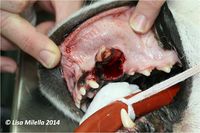Difference between revisions of "Luxated and Avulsed Teeth"
Jump to navigation
Jump to search
Michuang0720 (talk | contribs) |
|||
| (8 intermediate revisions by 2 users not shown) | |||
| Line 1: | Line 1: | ||
| − | |||
==Introduction== | ==Introduction== | ||
[[File:Luxated tooth.jpg|200px|right|thumb|Luxated tooth]] | [[File:Luxated tooth.jpg|200px|right|thumb|Luxated tooth]] | ||
Occasionally, veterinarians are presented with luxated or avulsed teeth. | Occasionally, veterinarians are presented with luxated or avulsed teeth. | ||
| − | Luxated = partly dislocated from the socket | + | Luxated = partly dislocated from the socket |
Avulsed = completely removed/pulled out of the socket | Avulsed = completely removed/pulled out of the socket | ||
| − | In these cases of trauma, the blood supply to the tooth is affected, resulting in | + | In these cases of trauma, the blood supply to the tooth is affected, resulting in pulp necrosis. |
| − | + | {{Unfinished}} | |
| − | |||
| − | |||
| − | |||
| − | |||
| − | |||
| − | |||
| − | |||
| − | |||
| − | |||
| − | |||
[[Category:Endodontic Conditions]] | [[Category:Endodontic Conditions]] | ||
| − | [[Category: | + | [[Category:LisaM reviewing]] |
| − | |||
| − | |||
Revision as of 15:12, 25 April 2014
Introduction
Occasionally, veterinarians are presented with luxated or avulsed teeth.
Luxated = partly dislocated from the socket
Avulsed = completely removed/pulled out of the socket
In these cases of trauma, the blood supply to the tooth is affected, resulting in pulp necrosis.
| This article is still under construction. |
